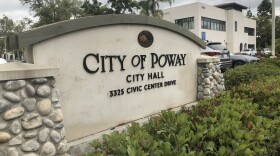







Along a barren dirt road, Border Patrol agents spot a mother and son, carrying nothing as they walk along the river's edge. The sun beats down on them as the patrol car pulls up.
"Where are you from?" Supervisory Border Patrol Agent Marlene Castro asks the mother. "How much did you pay to get here?"
Recent statistics from the Department of Homeland Security show "an unprecedented decline" in the numbers of people crossing the U.S.-Mexico border illegally. It announced a 40 percent drop from January to February, and credited the Trump administration's tough actions on immigration as the cause.
But in this corner of south Texas, every day still sees migrants trying to make it to the United States.
Celia, the mother, says she's from El Salvador. (We are not using her last name, at her request, because she fears for her safety.) On this part of the border, the majority of those trying to cross illegally are from Central America. Celia says she fled her country to protect her 17-year-old son from one of the most feared gangs in the country, the Mara Salvatrucha, better known as MS-13.
"They wanted to take him. I had to hide him at a friend's house while we fled the country. They wanted him to join them. And they threatened that, if he didn't, they would kill both of us," she recounts, crying.
"The situation is terrible because you can't trust the police. The police are linked to the gangs," Celia says. "I was going to file a complaint for the threats against us, but the gangs would have known about it immediately. That would have made it worse."
It's an irony that she's fleeing a gang that originated in Los Angeles in the 1980s. MS-13 was initially set up by Salvadoran immigrants who had relocated to the U.S. to get away from their country's brutal civil war, in which the U.S. was heavily involved. The FBI calls the group highly dangerous and violent. The chaos and insecurity they've brought to the region is one of the main causes of much of the migration from Central America.
"I've got a Christmas present for you," agent Castro speaks into her radio as she spots two more migrants down the road. It's a boy and a girl, both 17, who come from Guatemala and Honduras, respectively.
Castro then points to the other side of the Rio Grande toward Mexico, as other people pull a raft up from the water.
"Those are the smugglers," Castro says.
The river is narrow here and it's easy to spot them. She says she's seen cases of women and girls who have been sexually abused by the traffickers; men and boys who have been beaten.
"They prey on their desperation, on their ignorance, because they're not familiar with the laws, processes, anything."
Castro says U.S. Border Patrol has a good working relationship with the Mexican police. Still, she acknowledges the smugglers use the same safe houses over and over again, with little interference from Mexican authorities.
Under former President Obama, families likes these who were caught at the border would be processed and then set free until an immigration hearing could be scheduled, possibly years into the future, due to overburdened courts.
But that's changing under the Trump administration.
Supervisory Border Patrol Agent Daniel Hughbanks was called to the scene of the apprehensions. It's been frustrating to spend time capturing people, he says, only to see them let go.
"As a Border Patrol agent, it ties people up here doing this. If we're going to let people come in and just release them, why don't they just let them come to the port of entry and do it? It seems like we should be discouraging people from making illegal entries," Hughbanks says.
Homeland Security Secretary John Kelly has announced officials are now considering separating children from parents who entered the country illegally. The adults would be kept in detention and the children would be placed into protective custody until they can be handed over to a relative or put into foster care.
And it's not just new arrivals being threatened with separation from their children.
New threats call for new precautionary measures
Just north of the border, in the poor neighborhood of Las Milpas in Pharr, Texas, a community center holds a meeting packed full of mothers and children. The organization, ARISE, is helping the families prepare for possible deportation.
The organizers hand out "preparation kits." Most of the people in attendance are not authorized to be in the country.
While the Obama administration deported criminals who were in the country illegally, it generally left law-abiding families without documentation alone. Since the Trump administration has encouraged a more aggressive deportation strategy, many in this community say they're very afraid.
The kits have information on what the would-be immigrants' legal rights are if they're stopped by Border Patrol or even regular police. The kits also include draft custody forms; the organizers explain that it's vital for the parents to designate a legal guardian because their children could be put into foster care if they don't have one and the parents are deported. The mothers' faces look grave as they listen.
Eva is among them. (At her request, we're using only Eva's first name because she's in the U.S. illegally.) She has six children, but it's her 9-year-old boy who has become terrified that she'll be taken away.
"He comes home from school and the first thing he does is look for me," Eva says as she begins to cry. "He tells me, 'When I don't see you mommy, I think that you've been sent away to Mexico.' He can't concentrate at school because he is always so worried about his mom and dad."
She says she's planning to fill out the custody document but she's torn over whom to appoint. It's such a terrifying decision, she says, "I just don't trust that many people."
Eva knows how difficult a burden this will be on whoever may have to take her kids — she's already looking after the son of one of her friends who was deported. He has special needs and it's been very hard.
She says she tells her little ones to be brave.
"We don't want so many deportations, so many families being separated. That's not what we want," Eva says.
Debbie Nathan, who's with the American Civil Liberties Union, was also at the community meeting. She runs a hotline to report abuses by the Border Patrol or police and says she's hearing about an uptick in aggressive policing of neighborhoods where unauthorized immigrants live.
"It's terrorizing," she says. "People are telling me they don't go out of their houses. They used to take walks at night. They would walk the dog, they would go to the grocery store. I've heard stories about people not taking their children to child doctor visits — trying to figure out whether the child is sick or well enough that they can skip the visit."
Nathan says people feel intimidated. And while this has been going on for a while, it's gotten more pronounced under Trump.
"I've been on the border on and off for many years, and I've never seen anything like this," she adds.
A treacherous waiting ground
Across the border in Mexico, things are also difficult. NPR's John Burnett went to Reynosa, where the industrial city of 650,000 is feeling the burden of Trump's aggressive immigration enforcement policies.
The U.S. is deporting busloads of Mexicans and Central Americans who were in the country without permission and dropping them off in Reynosa and other Mexican border cities, sometimes in the middle of the night.
Reynosa is no place for immigrants, says Sister Maria Nidelvia-Avila, the director of the city's migrant shelter, Casa de Migrante.
"They're looking for a place to live," she says. "They're looking for work. They need food. They're insecure and poor. What are they to do?"
Reynosa is dealing with the dual influx of deportees from the north and migrants from the south — with little infrastructure to deal with the overflow.
This city has traditionally been a popular staging ground for people coming from elsewhere in Mexico and Central America to jump the border into Texas.
Migrants who made the long, dangerous trek to Reynosa are now finding themselves in limbo.
Antonio Herrera came all the way from La Ceiba, Honduras, with the intention of crossing illegally and finding work in the U.S. Now he's having second thoughts, as he kills time — day after day — in an immigrant shelter on the south side of the Rio Grande.
"Truthfully, we hope that God touches Mr. Trump's heart," Herrera says, adjusting his fedora, "and he gives us opportunity to come to the United States to work."
Coping from south of the border
But some in Mexico feel Trump's tough immigration is the harsh medicine that Mexico needs.
Inside the downtown Zaragoza Market, president of the local merchants' association, Patricio Hernandez, congratulates Trump for forcing Mexico to face reality.
"I don't like Trump's politics, but there's a good side to everything," he says. "Trump is taking care of Americans. We have to take care of our house. The Mexican government should be concerned about the illegals who went to the U.S., and the lack of work here in Mexico. Trump is forcing us to be responsible for our own house."
Hernandez recently did his part by hiring an unemployed man from southern Mexico to work in his jewelry store, making keys.
Horacio Gutierrez is a husky 30-year-old who traveled here, like many others, with the intention of using Reynosa as his departure point.
"My plan was to go to the United States," he says, "but then this president came and it's gotten tough for us. We're seeing he's deporting lots of people."
So Gutierrez makes keys in the marketplace, unable to send any money home to his family in Chiapas. "But," he says with a wan smile, "it's better to make less money here in Mexico, and not live in fear of the immigration police."
Back across the border in the U.S., we find the migrants we met being detained by Border Patrol. Celia and her son are at a migrant shelter, preparing for their journey to Los Angeles, where her brother lives. She says she's happy she's been let go from detention, but she has a court date in a few weeks where her fate will be decided.
"I feel some hope," she says. "I don't want to go back. I dream of my son studying in safety, that he will be fine. I hope I can find a job to support him."
I ask her if her long journey has been worth it.
The answer is one word.
"Yes."
NPR's Samantha Balaban and Ravenna Koenig contributed to this story.
Copyright 2017 NPR. To see more, visit http://www.npr.org/.






